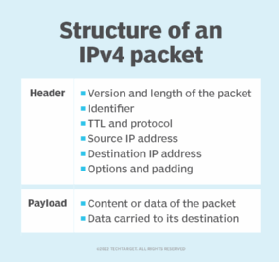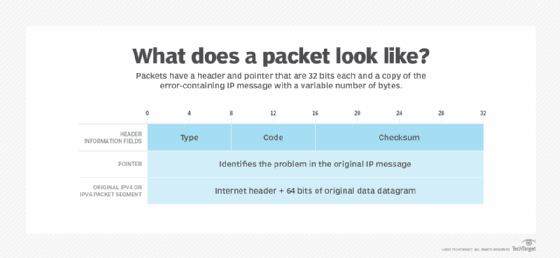What Does a Router Use to Decide Where Packets for Data Is Sent?
What is a network packet?
A network packet is a small amount of data sent over Transmission Control Protocol/Internet Protocol (TCP/IP) networks. The packet size is around 1.5 kilobytes for Ethernet and 64 KB for IP payloads.
A packet is the unit of data routed between an origin and a destination on the internet or other packet-switched network -- or networks that ship data around in small packets.
What is a packet-switched network?
Everything on the internet, including emails and webpages, makes use of network packets to send information between users and recipients. This approach to sending a network packet ensures information reliability so that data does not have to be sent as a single large file.
Each packet sent includes information such as the source and destination, protocols or identification.
How does a network packet work?
When any file, like an email message, Hypertext Markup Language, Graphics Interchange Format or Uniform Resource Locator request is sent on the internet, it is broken down into small chunks, or bytes. The TCP layer of TCP/IP divides the file into bytes for efficient routing. Typically, a packet holds 1,000 to 1,500 bytes of information.
Each packet is separately numbered and includes the internet address of the destination. The individual packets for a given file may take different routes over the internet. Upon arrival at their destination, the packets are reassembled into the original file by the TCP layer at the receiving end.
Depending on the type of network, packets can also be referred to by names such as block, cell, frame or segment.
A packet-switching scheme is an efficient way to handle transmissions on a connectionless network, such as the web. An alternative scheme, circuit-switched transmission, is used for voice networks. In circuit switching, lines in the network are shared among many users as with packet switching. However, each connection requires the dedication of a particular path for the duration of the connection.
What are the parts of a network packet?
Network packets are made up of three different parts: header, payload and trailer. Conceptually, they're like a postal package. In this scenario, the header is the box/envelope, the payload is content and the trailer is the signature.
The header contains instructions related to the data in the packet. These instructions can include the following:
- checksum, which detects errors;
- 16-bit identification number;
- flags to let a router know if it can fragment a packet;
- fragmentation offsets, which reconstruct fragmented packets;
- destination address;
- number of hops a packet can make;
- IP;
- length of the packet -- but not always, as some networks have fixed-length packets;
- size of the header and payload;
- time-to-live;
- originating address;
- packet number, in relation to the packet sequence;
- protocol or what type of packet is transmitted; and
- synchronization or the few bits that enable the packet to match up to the network.
The payload is the data within the packet. This is the basic information that the packet delivers to the destination. The payload is often padded with blank information to accommodate a fixed-length packet.

Sometimes called the footer, trailers are bits that signify the end of a packet. These bits inform the receiving device that it has reached the end of the packet. Trailers may also include a type of error checking protocol.
The most common type of error checking is called a cyclic redundancy check (CRC). On certain computer networks, CRC adds up all of the 1s in the payload before storing the result as a hexadecimal value. Upon receipt, the receiving device compares the sum of 1s in the payload to the value stored in the trailer. If the values match, it's a good packet. If they do not match, the receiving device sends a request to the originating device to resend the packet.
Common questions and answers about network packets
What is network packet loss?
Packet loss occurs when a packet with data fails to arrive at its destination. Internet packet loss can happen for several reasons, including mistakes made during data transmission and network congestion.
What is a network packet broker?
Network packet broker technologies implement various monitoring tools to access and analyze network packets or traffic traveling across a network. A network packet broker functions like a manager of network traffic.
What is network packet sniffing (traffic analysis)?
Network traffic analysis is often referred to as packet sniffing. A packet analyzer or network sniffer can be a piece of hardware or software that monitors network traffic. Network packet sniffers examine streams of data packets flowing between computers on a network. They also analyze traffic between networked computers and the internet.
Examples of packet sniffing tools are NetFlow Analyzer, Tcpdump and Wireshark.

What is network packet capture?
Packet capture is the interception of data packets that cross through a specific point in the network. Captured in real time, the packet is stored for analysis, archived, downloaded or discarded.
What is the network packet size in a SQL server?
The default network packet size in an Structured Query Language (SQL) server is 4,096 bytes. The largest network packet size for encrypted transmissions is 16,383 bytes.
How to troubleshoot packet loss on a network?
Troubleshooting network packet loss is done using application performance monitoring tools.
Here are five steps used to troubleshoot:
- Isolate the root cause of packet loss.
- Assess the service provider based on the results of step 1.
- Configure network settings.
- Check all network hardware components.
- Monitor for potential packet loss.
What is the requirement of a connectionless packet-switched network?
The only requirement for connectionless packet-switched networks is an identifier. The network will determine the route each packet takes over a virtual circuit built for the duration of the packet delivery.
What is a network packet generator?
A network packet generator is a tool that enables the administrator to construct Address Resolution Protocol/Reverse ARP, Cisco Discovery Protocol, Internet Control Message Protocol, and User Datagram Protocol (UDP) or raw packets and send them either as a single packet or multiple packets. This packet of information can be sent to an IPv4 address or IPv6 address.
What is the difference between a packet and a datagram?
The words packet and datagram are similar in meaning. A protocol similar to TCP, UDP uses the term datagram instead of packet.
What Does a Router Use to Decide Where Packets for Data Is Sent?
Source: https://www.techtarget.com/searchnetworking/definition/packet
0 Response to "What Does a Router Use to Decide Where Packets for Data Is Sent?"
Post a Comment